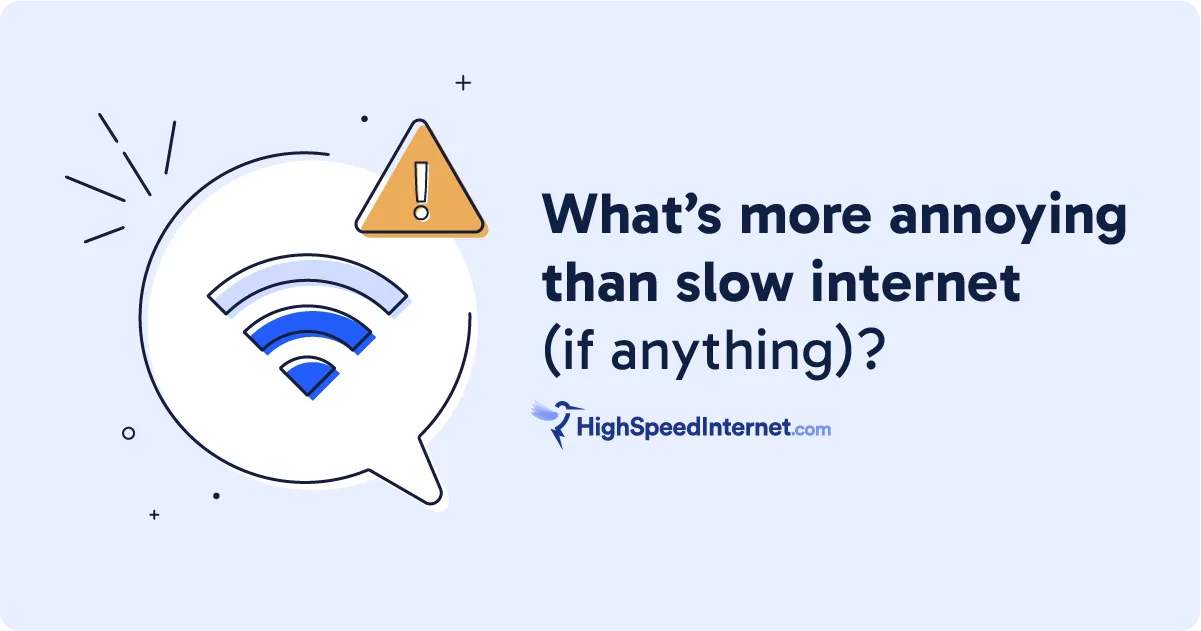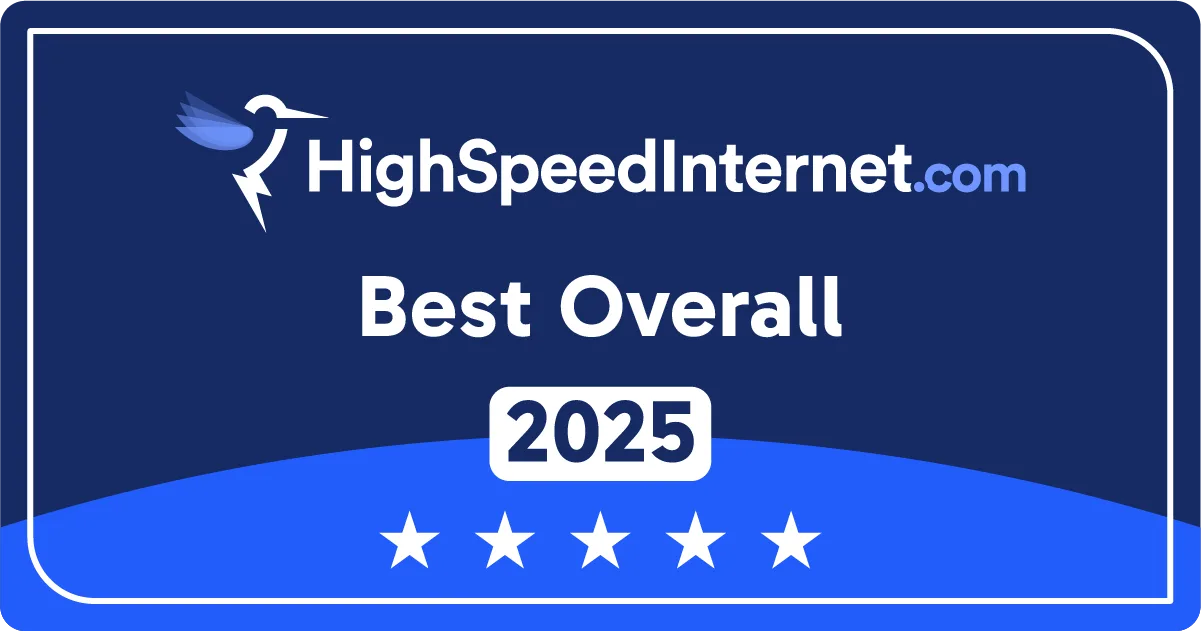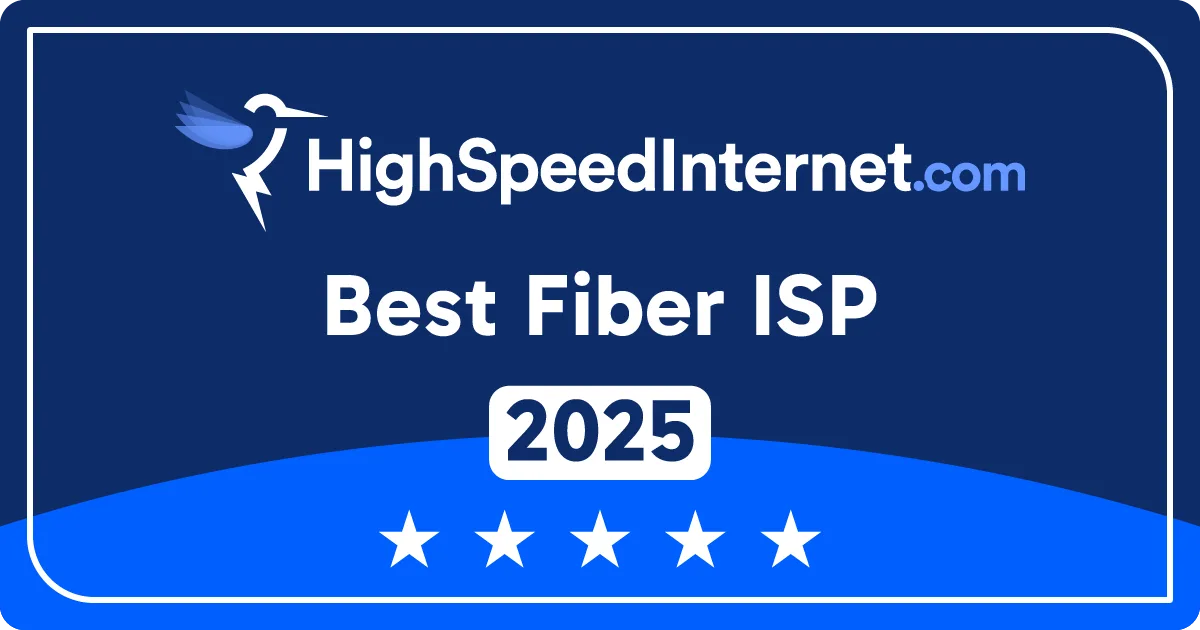Fastest Internet Provider 2025: Brightspeed
Brightspeed’s new fiber network achieves the fastest speeds nationwide, highlighting progress stalls with larger providers
Mar 26, 2025 | Share
Annual Review, Data and Research, Featured

It’s been a strange year for internet performance in the United States. Data from the HighSpeedInternet.com speed test indicates the overall improvement of internet speed in the country has slowed by more than 50%, an unexpected development as both cable and fiber internet have seen substantial technological advances. Are internet service providers (ISPs) dragging their feet with the next wave of internet tech? Thankfully, the disappointing trend isn’t present in the data for all providers.
Brightspeed, the youngest ISP in our performance analysis, shattered last year’s fastest speed and ran laps around every other major ISP except one. Since the company’s launch in 2022, Brightspeed’s all-star leadership team has been transparent with its fiber expansion build, which has included some unconventional decisions that may set the template for fiber builds going forward if the success continues.
Internet speed gains decelerate in the United States
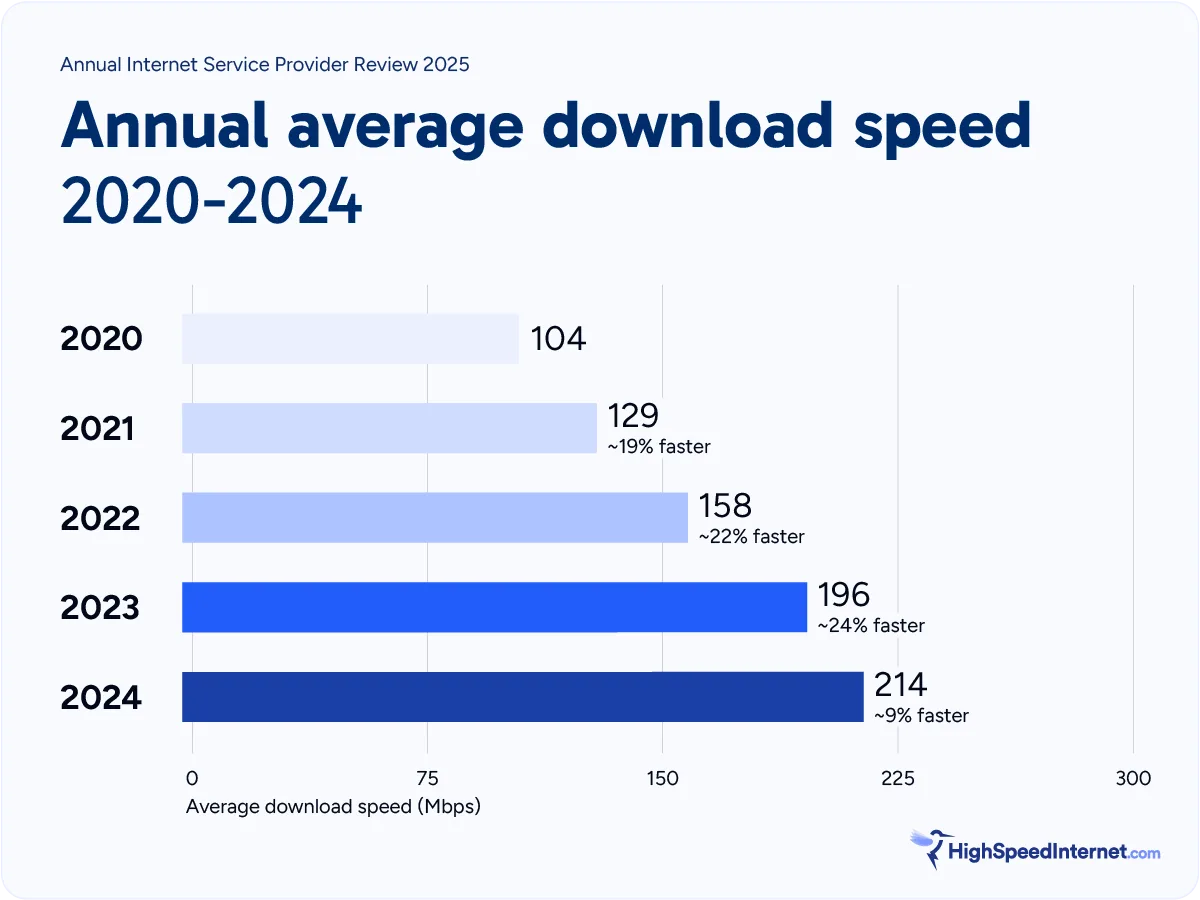
Every year, several factors improve internet performance. Providers release speed upgrades and faster plans. New routers and devices equipped with improved Wi-Fi protocols make their way into customers’ homes. Sometimes, there are huge technological leaps that substantially boost the capabilities of ISPs.
The good news is internet performance improved year-over-year, as it always does. The bad news is it did not improve nearly as much as it usually does. In fact, internet speed gains fell by approximately 58% in 2024, the weakest results we’ve seen since we began our performance tracking.
It’s important to note that a decrease in improvement doesn’t necessarily mean ISPs are doing anything wrong or worse than before. We may just be seeing an adjustment in the internet needs of the average household. Customers could be simply choosing cheaper and slower internet plans as the country drifts further away from the pressures of the pandemic, such as remote work.
Technologically speaking, the 2024 calendar year should have brought major gains with key technologies for cable and fiber internet set for major deployment. In late 2023, cable internet giant Xfinity announced the deployment of DOCSIS 4.0, a new technology that can bring multi-gigabit symmetrical speeds to cable internet households. But Xfinity’s initial rollout was a small portion of its footprint. Today, Xfinity DOCSIS 4.0 tech covers over one million homes, but that’s still far too few of Xfinity’s more than 31 million customers. Comcast announced last September plans to ramp up the rollout significantly.
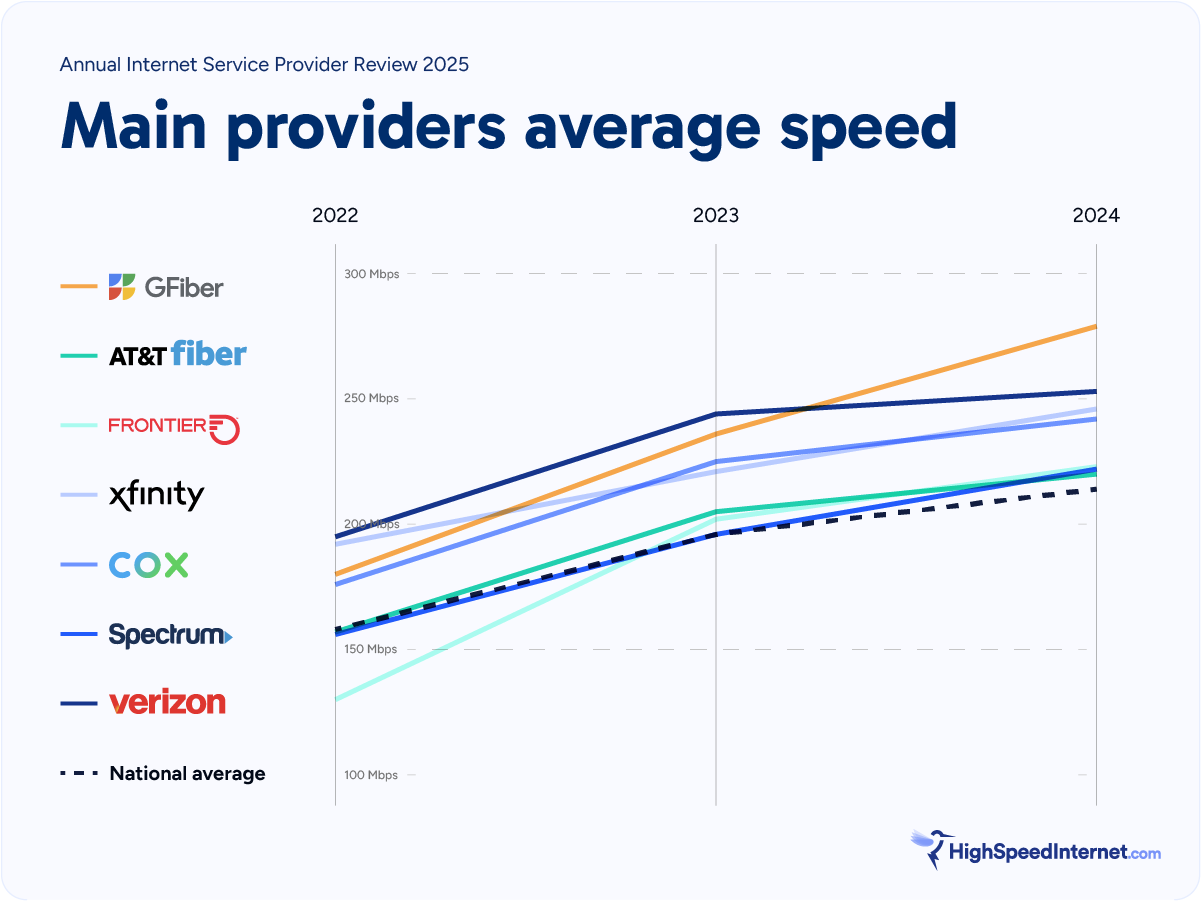
Unfortunately, other cable providers are even further behind in applying the new tech. Spectrum, the country’s second-largest cable ISP, had originally announced plans to complete the deployment of DOCSIS 4.0 in 2025. But in February of last year, Spectrum pushed that completion target into 2026. And just last November, Spectrum delayed its DOCSIS 4.0 rollout again, with the new target completion date now set in 2027.
The lack of urgency continues with the third largest cable provider, Cox, which mentioned briefly in mid-2023 that it planned to deploy DOCSIS 4.0 in the second half of 2025, but the ISP has said nothing of those plans since that brief statement.
Cable internet connects more households than any other internet type, with approximately 47% of the country’s internet customers (estimated in 2023), hence why its stall profoundly affects national performance. We know that DOCSIS 4.0 has the potential to keep cable internet competitive, but ISPs need to speed up deployment in order to return to the improvement trajectory we saw as recently as last year.
It’s a very different story with fiber connections, which appear to have a much healthier rate of acceleration. New fiber advancements, like XGS-PON architecture, are being quickly implemented in earnest, resulting in huge network-wide gains.
“This is a fundamentally different way to deploy a better network. GFiber is upgrading our entire network infrastructure — proactively replacing our GPON network with XGS PON — not picking and choosing specific neighborhoods or streets…” wrote John Keib, Chief Technology & Product Officer at GFiber (Google Fiber), in May of last year. In the same post, Keib also stated that GFiber expected all new customers to be on XGS-PON infrastructure by the end of 2024.
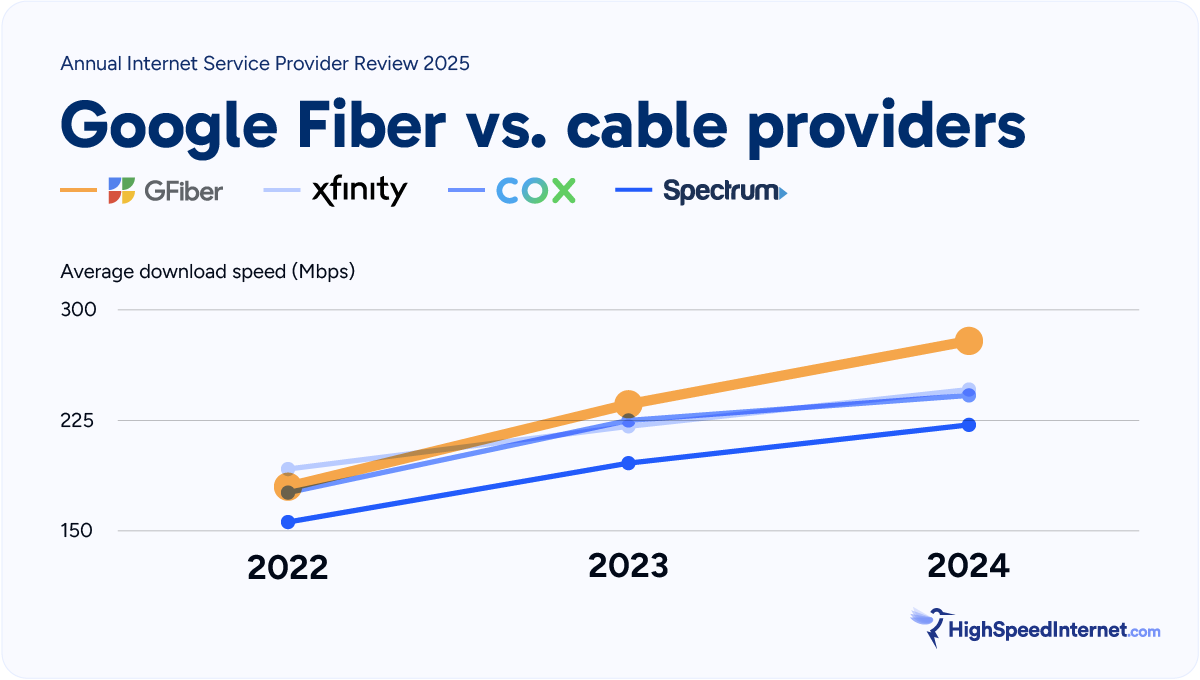
Google Fiber is one of the few provider data sets that give us a clear picture of fiber performance, as lingering DSL connections negatively skew data for other major fiber ISPs. Not only are Google Fiber’s average numbers sky high, but comparing Google Fiber to big cable shows a clear advantage in fiber internet’s rate of improvement. We expect the same to be true for other fiber ISPs like Verizon and AT&T when DSL connections are removed from the data. However, there’s one fiber ISP that managed to surpass Google Fiber (and every other ISP) despite a sizable DSL customer base: Brightspeed.
Fastest ISP: Brightspeed
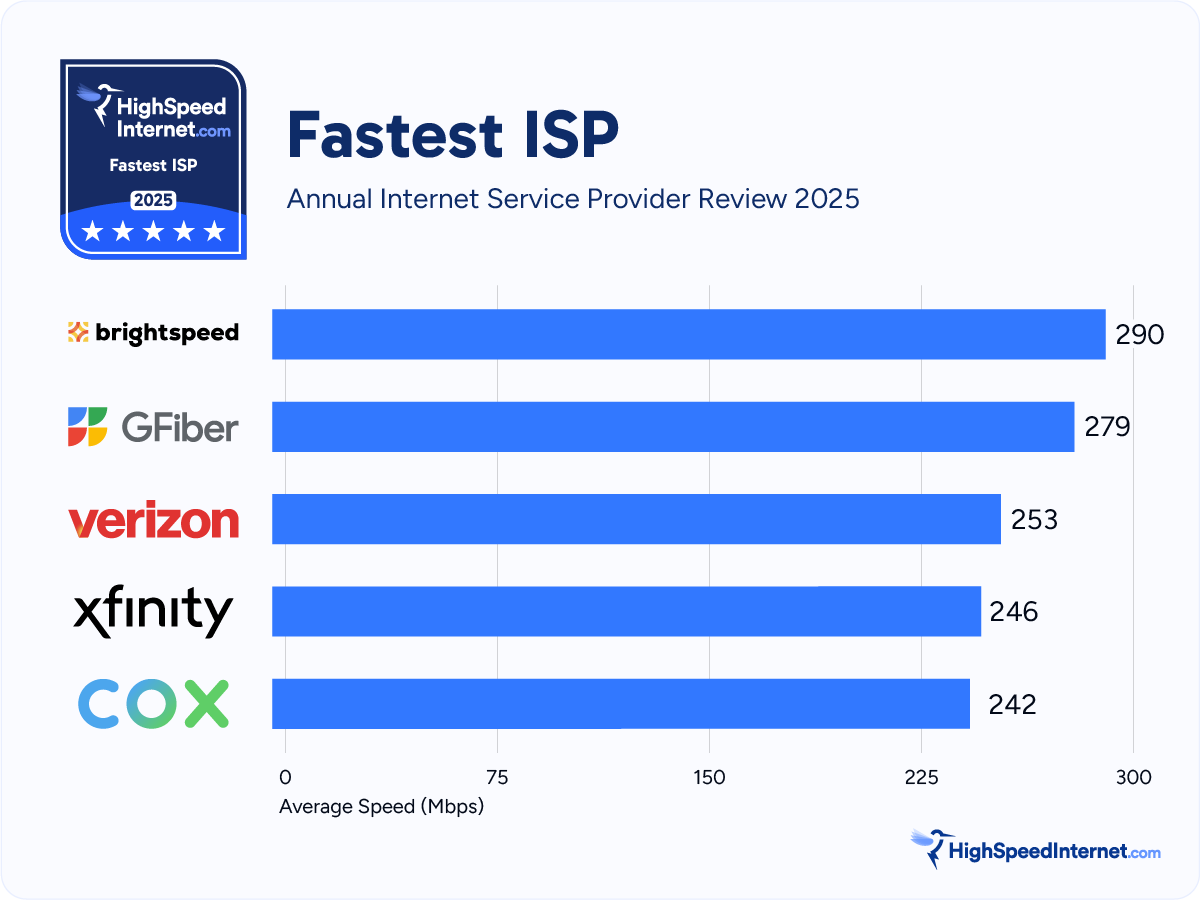
Brightspeed is the fastest internet provider in the U.S., with an average speed of 290Mbps, far surpassing last year’s top speed of 242Mbps. The new speed record distinguishes Brightspeed in a new tier with the usual speed champions such as Cox, Xfinity, and Verizon all lingering closer to last year’s numbers. The only other provider that comes close is Google Fiber at 279Mbps, but Brightspeed is still comfortably ahead. Brightspeed’s fiber connections likely outperform Google Fiber’s by an even greater degree than represented in our data, as our analysis does not filter out Brightspeed’s considerable DSL customer base.

From its inception through the present, Brightspeed’s success has been fostered by an elite telecommunications leadership team: Bob Mudge, Tom Maguire, and Chris Creager, all of whom are former leaders of Verizon during many of its most critical fiber builds.
A state-of-the-art fiber network had been the game plan from day one when Apollo Management first approached former Executive Vice President of Verizon, Bob Mudge, about purchasing ILEC assets. As the plan developed, Maguire and Creager were soon involved, and Apollo asked if any of the three would consider staying on to guide the new ISP. “We told him ‘You can either take all three of us or none of us,’” Maguire told Telecompitor.
In August 2021, it was announced that Apollo would spend $7.5 billion to acquire a 20-state local service area from CenturyLink, with most of the network serving DSL to suburban and rural areas. Only months later, the brand followed up with an ambitious $2 billion fiber build with the goal of covering half of the Brightspeed footprint with fiber-to-the-home (FTTH) connections and reaching up to 3 million homes over five years—an enormous task considering that the Brightspeed footprint only included 2–3% fiber connections at the time the network switched hands. Thankfully, Brightspeed had aligned the best team for the job.
Brightspeed’s first CEO, Bob Mudge, has been championing FTTH connections since 2012 when he oversaw Verizon Fios’s pioneering fiber builds. At the time, FTTH was seen as unnecessarily expensive and overkill by some ISPs, like AT&T, which experimented first with a fiber-to-the-neighborhood approach using the now-extinct AT&T U-verse platform. Mudge insisted that powerful FTTH connections were the way to go for a futureproof network, and as we all know now, he was right.
Tom Maguire, a fiber operations leader with over 40 years of experience, was also on the initial leadership team. Tom started as a field technician and eventually became Verizon’s Vice President of National Operations, leading a 35,000-strong telco workforce of fiber techs, engineers, and operations teams.
Almost immediately, Brightspeed released a flurry of detailed fiber build plans for each area, one after another, in a five-month span. Quick implementation, network quality, and maximum coverage were the priorities. Knowing what obstacles were likely to gunk up progress on a fiber build, the leadership team took direct action to avoid some of the usual pitfalls.
Splicing is one of the most costly aspects of building a fiber network. Fiber cables are typically harder to link together than copper or coaxial lines. The glass must be fused perfectly, a lengthy and expensive process, with a limited number of available professionals skilled enough to do the work. Brightspeed got around this headache by opting for easy Pushlok fiber cable connectors and plug-and-play terminals from Corning, substantially reducing the build’s need for splicing.
The next puzzle piece was designing a network that could be built quickly. Even after cutting costs by averting much of the splicing, laying fiber is still very expensive. Brightspeed chose a distributed split network design that achieves the same fiber coverage with fewer miles of fiber.
Fiber networks often rely on fiber distribution hubs that split the signal from one central location. Brigthspeed’s distributed split architecture distributes those splitters across a cascading network, bringing split points closer to customer homes and saving miles of fiber. It’s an uncommon build strategy in the U.S., especially for footprints that cover many rural areas as Brightspeed’s does, but that’s why you hire people like Mudge and Maguire with the experience to seize these unconventional but highly effective opportunities.
So far, it seems Brightspeed has made all the right calls. It’s built out a top-tier fiber network at breakneck speed, closing out 2024 with 1.82 million fiber locations and the fastest real-world speeds in the nation.
Speed gains are down, but customer approval is… up?
Despite most providers and the internet as a whole showing a reduced rate of improvement, most ISPs saw improved customer ratings compared to our previous survey. In our most recent customer satisfaction survey, which asked 10,000 Americans to rate their internet service, providers averaged overall satisfaction ratings of 4.1 out of 5, significantly higher than the 2023 average of 3.7 out of 5.
Internet customers prioritize fast upload speeds
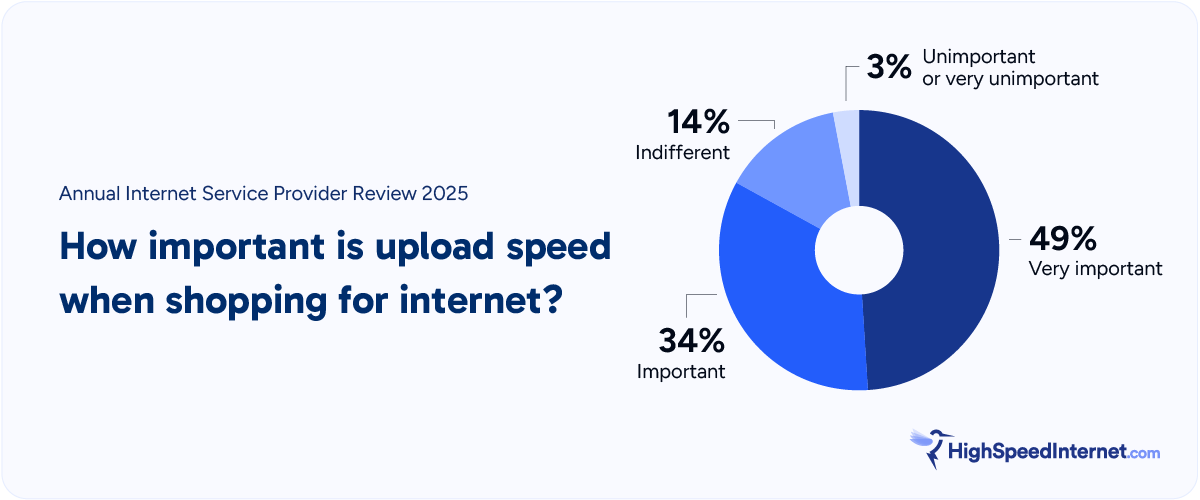
We asked 10,000 internet customers how important upload speed was to them when choosing an internet service; the overwhelming majority declared upload speed was an important factor. Just under half (49%) of respondents said upload speed was very important, with only 17% of customers undecided or uncaring of fast upload speed.
Almost everything we do online uses primarily download bandwidth, aside from a few activities like cloud backups and large file uploads. We prefaced our question with this important consideration, and still, customers were fiercely adamant that high upload speed was an important element of their service.
Get Brightspeed now
| Plan | Price | Speed |
|---|---|---|
| Up to 15 Mbps | $55.00/mo.* | Up to 15Mbps |
| Internet DSL | $55.00/mo.† | 40Mbps |
| Fiber 200 | $29.00/mo.‡ | 200Mbps |
| Fiber 500 | $39.00/mo.‡ | 500Mbps |
| Fiber 1 Gig | $59.00/mo.‡ | 940Mbps |
| Fiber 2 Gig | $89.00/mo.‡ | 2,000Mbps |
Disclaimers
* Autopay required. Installation fee may apply. Limited availability in select areas. Prices may vary depending on location.
† Monthly prepayment required. Additional taxes, fees, and surcharges apply. Limited availability in select areas. Prices may vary depending on location.
‡ Ltd avail/areas. Ltd time offer; qualifying, new Brightspeed customers only. Subj to change. Promotion offered through bill credit. Std rates apply after promotion period. Select plans only.
Author - Austin Aguirre
Austin worked as a broadband technician installing and troubleshooting countless home internet networks for some of the largest ISPs in the U.S. He became a freelance writer in 2020 specializing in software guides. After graduating with a BS in technical communication from Arizona State University, he joined the team at HighSpeedInternet.com where he focuses on home network improvement and troubleshooting.
Editor - Jessica Brooksby
Jessica loves bringing her passion for the written word and her love of tech into one space at HighSpeedInternet.com. She works with the team’s writers to revise strong, user-focused content so every reader can find the tech that works for them. Jessica has a bachelor’s degree in English from Utah Valley University and seven years of creative and editorial experience. Outside of work, she spends her time gaming, reading, painting, and buying an excessive amount of Legend of Zelda merchandise.


